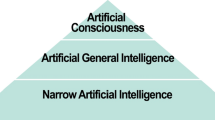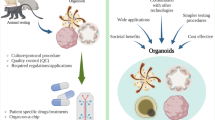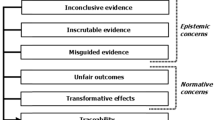Abstract
By many accounts, CRISPR gene-editing technology is revolutionizing biotechnology. It has been hailed as a scientific game changer and is being adopted at a break-neck pace. This hasty adoption has left little time for ethical reflection, and so this paper aims to begin filling that gap by exploring whether CRISPR is as much an ethical game changer as it is a biological one. By focusing on the application of CRISPR to non-human animals, I argue that CRISPR has and will continue to result in significant shifts in the ethical debate landscape. For instance, the fact that many CRISPR edits are non-transgenic has important implications for the ethical debate, particularly the popular objection to genetic engineering that it objectionably involves “crossing species boundaries,” as well as the regulatory debate in the United States, where currently only transgenic organisms are officially genetically modified organisms. I also explore various impacts CRISPR may have on animal welfare, suggesting that although the improved precision of CRISPR suggests fewer unintended welfare problems in comparison to past techniques, the greater versatility means that more animals than ever will be engineered. Finally, I end my discussion of animal welfare issues by exploring the possibility of using CRISPR to directly improve animal welfare, for instance through introducing disease resistance.
Similar content being viewed by others
Notes
Some might suggest that humans have been “genetically engineering” animals for thousands of years by way of selective breeding. Without intending to take a stand on the general debate, I am using “genetic engineering techniques” to refer just to those techniques that specifically, directly, and knowingly target the genome of plants and animals.
This attention is best exemplified by Robert and Baylis’s article and its many commentaries in the American Journal of Bioethics.
Public justification, in its less philosophical form, also seems to be important to many of the most vocal CRISPR researchers, including Jennifer Doudna. These researchers are deeply interested in the public being involved in policy debates over the regulation framework for CRISPR and gene-editing. See, e.g., Doudna (2015).
Strictly speaking, the USDA and FDA are only required to examine transgenic organisms, but they may elect to examine non-transgenic organisms. However, this tends not to occur.
The distinction between what I am calling mentalistic aspects and species-typical behavior aspects of welfare is also sometimes discussed as a distinction between “experiential” and “functional” welfare. Commonly, in that taxonomy, physical health is distinguished from welfare entirely.
Technically, the double-muscled pigs discussed by Cyranoski were created using TALENs, not CRISPR. However, expanding that type of edit to other animals, or other labs, will likely be cheaper and easier with CRISPR. This is especially true because the edit is quite simple, requiring a simple cut of the myostatin gene that inhibits the growth of muscle cells. While TALENs is still more precise for “knock-ins” (the addition of genes), CRISPR is largely on a par in terms of precision for “knock-outs” like this. See (Carroll and Charo 2015) for discussion of CRISPR and double-muscled animals.
References
Baltimore, D., Berg, P., Botchan, M., Carroll, D., Charo, R. A., Church, G., et al. (2015). A prudent path forward for genomic engineering and germline gene modification. Science, 348(6230), 36–38.
Bennett, A. B. (2012). Taste: Unraveling tomato flavor. Current Biology, 22(11), 1035–1039.
Bracke, M. B. M., & Hopster, H. (2006). Assessing the importance of natural behavior for animal welfare. Journal of Agricultural and Environmental Ethics, 19(1), 77–89.
Bradley, B. (2015). Is death bad for a cow? In T. Višak & R. Garner (Eds.), The ethics of killing animals (pp. 51–64). Oxford: Oxford University Press.
Carroll, D., & Charo, R. A. (2015). The societal opportunities and challenges of genome editing. Genome Biology, 16(1), 242.
Charo, R. A., & Greely, H. (2015). CRISPR critters and CRISPR cracks. The American Journal of Bioethics, 15(12), 11–17.
Comstock, G. L. (2000). Vexing nature? On the ethical case against agricultural biotechnology. Boston: Springer.
Cowan, C. (2015). Measuring off-target events, efficiency, and utility. Presented at the Informationgathering meeting for the planning committee organizing the international summit on human gene editing. Washington, DC
Cyranoski, D. (2015). Super-muscly pigs created by small genetic tweak. Nature, 523(7558), 13.
Cyranoski, D., & Reardon, S. (2015). Embryo editing sparks epic debate. Nature, 520(7549), 593–594.
De Vries, R. (2006). Genetic engineering and the integrity of animals. Journal of Agricultural and Environmental Ethics, 19(5), 469–493.
Doudna, J. A. (2015). My whirlwind year with CRISPR. Nature, 528(7583), 469–471.
Doudna, J. A., & Charpentier, E. (2014). The new frontier of genome engineering with CRISPR-Cas9. Science, 346(6213), 1258096.
Doudna, J. A., & Gersbach, C. A. (2015). Genome editing: The end of the beginning. Genome Biology, 16(1), 292.
Esvelt, K. M., Smidler, A. L., Catteruccia, F., & Church, G. M. (2014). Concerning RNA-guided gene drives. eLife, 2014(3), e03401.
Fagerlund, R. D., Staals, R. H. J., & Fineran, P. C. (2015). The Cpf1 CRISPR-Cas protein expands genome-editing tools. Genome Biology, 16(1), 251.
Fox, M. W. (1989). Genetic engineering and animal welfare. Applied Animal Behaviour Science, 22(2), 105–113.
Fox, M. W. (1990). Transgenic animals: Ethical and animal welfare concerns. In P. Wheale & R. McNally (Eds.), The bio-revolution: Cornucopia or Pandora’s box. London: Pluto Press.
Fraser, D., Weary, D. M., Pajor, E. A., & Milligan, B. N. (1997). A scientific conception of animal welfare that reflects ethical concerns. Animal Welfare, 6(3), 187–205.
Frock, R. (2015). Measuring off-target events, efficiency, and utility. Presentation, National Academy of Sciences, Washington, DC. Published online: https://vimeo.com/142678537. Accessed Dec 15, 2017.
Fu, Y., Foden, J. A., Khayter, C., Maeder, M. L., Reyon, D., Joung, J. K., et al. (2013). High-frequency off-target mutagenesis induced by CRISPR-Cas nucleases in human cells. Nature Biotechnology, 31(9), 822–826.
Fu, Y., Sander, J. D., Reyon, D., Cascio, V. M., & Joung, J. K. (2014). Improving CRISPR-Cas nuclease specificity using truncated guide RNAs. Nature Biotechnology, 32(3), 279–284.
Gersbach, C. A. (2014). Genome engineering: The next genomic revolution. Nature Methods, 11(10), 1009.
Hauskeller, M. (2005). Telos: The revival of an Aristotelian concept in present day ethics. Inquiry, 48(1), 62–75.
Hilton, I. B., D’Ippolito, A. M., Vockley, C. M., Thakore, P. I., Crawford, G. E., Reddy, T. E., et al. (2015). Epigenome editing by a CRISPR-Cas9-Based acetyltransferase activates genes from promoters and enhancers. Nature Biotechnology, 33(5), 510–517.
Kasperbauer, T. J. (2013). Nussbaum and the capacities of animals. Journal of Agricultural and Environmental Ethics, 26(5), 977–997.
Kasperbauer, T. J., & Sandøe, P. (2015). Killing as a welfare issue. In T. Višak, & Garner, R. (Eds.), The ethics of killing animals (pp. 17–31). Oxford: Oxford University Press.
Kuzma, J. (2016). Reboot the debate on genetic engineering. Nature, 531(7593), 165–167.
Ledford, H. (2015a). CRISPR, the disruptor. Nature, 522(7554), 20–24.
Ledford, H. (2015b). Biologists create more precise molecular scissors for genome editing. Nature. News, 1 Dec 2015. https://doi.org/10.1038/nature.2015.18932.
Ledford, H. (2016). Riding the CRISPR wave. Nature, 531(7593), 156–159.
Macnaghten, P. (2004). Animals in their nature: A case study on public attitudes to animals, genetic modification and ‘nature’”. Sociology, 38(3), 533–551.
Mariscal, C., & Petropanagos, A. (2016). CRISPR as a driving force: The Model T of biotechnology. Monash Bioethics Review, 34(2), 101–116.
Maxmen, A. (2017). Gene-edited animals face US regulatory crackdown. Nature. https://doi.org/10.1038/nature.2017.21331.
Midgley, M. (2000). Biotechnology and monstrosity: Why we should pay attention to the ‘Yuk Factor’. Hastings Center Report, 30(5), 7–15.
Ormandy, E., & Griffin, G. (2011). Genetic engineering of animals: Ethical issues, including welfare concerns. The Canadian Veterinary Journal, 52(5), 544–550.
Ormandy, E., & Schuppli, C. (2014). Public attitudes toward animal research: A review. Animals, 4(3), 391–408.
Rawls, J. (2005). Political liberalism (2nd ed.). New York: Columbia University Press.
Reardon, S. (2015). New life for pig organs. Nature, 527(7577), 152.
Reardon, S. (2016). The CRISPR zoo. Nature, 531(7593), 160–163.
Robert, J. S., & Baylis, F. (2003). Crossing species boundaries. American Journal of Bioethics, 3(3), 1–13.
Rollin, B. E. (1996). The Frankenstein Syndrome: Ethical and social issues in the genetic engineering of animals. New York: Cambridge University Press.
Rollin, B. E. (2003). Ethics and species integrity. American Journal of Bioethics, 3(3), 15–17.
Rozin, P. (2005). The meaning of ‘natural’ process more important than content. Psychological Science, 16(8), 652–658.
Rutgers, L. J. E., & Heeger, F. R. (1999). Inherent worth and respect for animal integrity. In M. Dol, M. F. Van Vlissingen, S. Kasanmoentalib, T. Visser, & H. Zwart (Eds.), Recognizing the intrinsic value of animals: Beyond animal welfare (pp. 41–52). Assen: Van Gorcum Ltd.
Schaefer, K. A., Wu, W. H., Colgan, D. F., Tsang, S. H., Bassuk, A. G., & Mahajan, V. B. (2017). Unexpected mutations after CRISPR-Cas9 editing in vivo. Nature Methods, 14(6), 547–548.
Schultz-Bergin, M. (2017). The dignity of diminished animals: Species norms and engineering to improve welfare. Ethical Theory and Moral Practice, 20(4), 843–856.
Schuppli, C. A., Molento, C. F. M., & Weary, D. M. (2015). Understanding attitudes towards the use of animals in research using an online public engagement tool. Public Understanding of Science, 24(3), 358–374.
Schuppli, C. A., & Weary, D. M. (2010). Attitudes towards the use of genetically modified animals in research. Public Understanding of Science, 19(6), 686–697.
Shawlot, W., & Behringer, R. R. (1995). Requirement for Lim1 in head-organizer function. Nature, 374(6521), 425–430.
Sherkow, J. S., & Greely, H. T. (2013). What if extinction is not forever? Science, 340(6128), 32–33.
Siegel, A. W. (2003). The moral insignificance of crossing species boundaries. American Journal of Bioethics, 3(3), 33–34.
Specter, M. (2015). The gene hackers. In The New Yorker, 16 Nov 2015. https://www.newyorker.com/magazine/2015/11/16/the-gene-hackers. Accessed Dec 17, 2017.
Specter, M. (2016). The perils and promises of gene-drive technology. In The New Yorker, 10 June 2016. https://www.newyorker.com/news/daily-comment/the-perils-and-promises-of-gene-drive-technology. Accessed Dec 17, 2017.
Specter, M. (2017). Rewriting the code of life. In The New Yorker. 2 Jan 2017. https://www.newyorker.com/magazine/2017/01/02/rewriting-the-code-of-life. Accessed Dec 17, 2017.
Streiffer, R. (2003). In defense of the moral relevance of species boundaries. American Journal of Bioethics, 3(3), 37–38.
Streiffer, R., & Hedemann, T. (2005). The political import of intrinsic objections to genetically engineered food. Journal of Agricultural and Environmental Ethics, 18(2), 191–210.
Sun, Y. G., Gao, Y. G., Zhao, Z. Q., Huang, B., Yin, J., Taylor, G. A., et al. (2008). Involvement of P311 in the affective, but not in the sensory component of pain. Molecular Pain, 4(1), 23.
Tanyi, A. (2015). On the intrinsic value of genetic integrity. Ethics, Policy & Environment, 18(3), 248–251.
Thompson, P. B. (1997). Ethics and the genetic engineering of food animals. Journal of Agricultural and Environmental Ethics, 10(1), 1–23.
Vallier, K., & D’Agostino, F. (2014). Public justification. In E. Zalta (Ed.), Stanford encyclopedia of philosophy. http://plato.stanford.edu/archives/spr2014/entries/justification-public/. Accessed Dec 15, 2017.
Vora, S., Tuttle, M., Cheng, J., & Church, G. M. (2016). Next stop for the CRISPR revolution: RNA-guided epigenetic regulators. The FEBS Journal, 283(17), 3181–3193.
Vorstenbosch, J. (1993). The concept of integrity: Its significance for the ethical discussion on biotechnology and animals. Livestock Production Science, 36(1), 109–112.
Waltz, E. (2016). Gene-edited CRISPR mushroom escapes US regulation. Nature, 532(7599), 293.
Zetsche, B., Volz, S. E., & Zhang, F. (2015). A split-Cas9 architecture for inducible genome editing and transcription modulation. Nature Biotechnology, 33(2), 139–142.
Zhang, L., & Zhou, Q. (2014). CRISPR/Cas technology: A revolutionary approach for genome engineering. Science China Life Sciences, 57(6), 639–640.
Acknowledgements
This paper greatly benefited from the feedback of two anonymous referees as well as the editors of this special issue. Additionally, some of the arguments here were first presented to the Functional Genomics Initiative at Washington State University and I’d like to thank those in attendance for the helpful discussion. Finally, I’d like to thank Tatiana Gracyk for reviewing previous versions of this paper and helpful discussions of the ideas.
Author information
Authors and Affiliations
Corresponding author
Rights and permissions
About this article
Cite this article
Schultz-Bergin, M. Is CRISPR an Ethical Game Changer?. J Agric Environ Ethics 31, 219–238 (2018). https://doi.org/10.1007/s10806-018-9721-z
Accepted:
Published:
Issue Date:
DOI: https://doi.org/10.1007/s10806-018-9721-z




